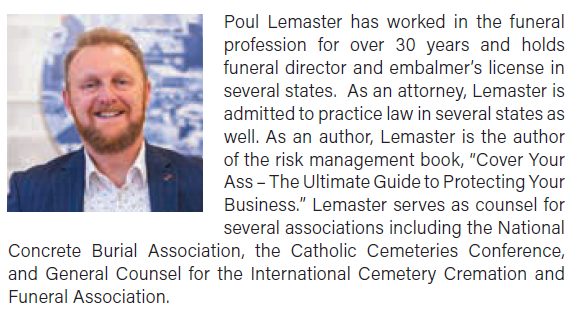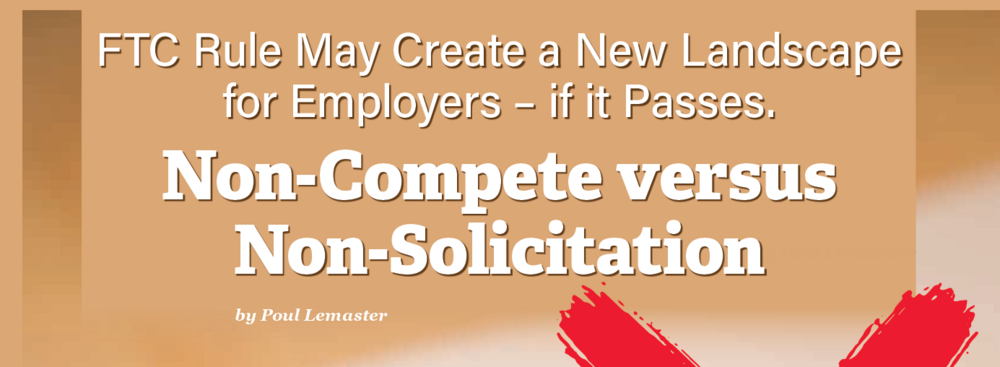(404) 312-6640
FTC Rule May Create a New Landscape for Employers – if it Passes. Non-Compete versus Non-Solicitation
The Federal Trade Commission (FTC) has proposed a rule that would ban all non-competes. The Rule, known as the ‘hold on to your seats for this one,’ ok, actually it’s the ‘Non-compete Clause Rule’ or ‘Rules Concerning Unfair Methods of Competition’ would ban all non-competes. Understand that ‘all non-competes’ includes both all future non-competes as well as those already in existence. You read that correctly, this rule, if implemented, would reach back, and void all current non-competes. You are probably now asking why this is an issue, and why does the FTC think it needs fixed. Here is what the FTC states.
Over 30 million people in the United States are bound by a non-compete clause (that’s 1 in 5 of you reading this article right now.) The FTC has shared data as to what happens because of these non-competes. First, the FTC states that non-competes reduce employee wages, because an employer does not have to worry about them leaving; allowing employers to suppress wages. The FTC believes a ban on non-competes could increase wages as much as $300 billion per year.
The FTC also believes that non-competes stifle new ideas as well as new businesses. The thought process is that someone who is under a non-compete is inhibited from sharing new ideas because they can’t share them with new companies, but rather only the company they work for currently. Lastly, the FTC argues that non-competes exploit workers, because it takes away bargaining power due to the typical take-it-or-leave-it contracts that employees must choose. And once under a non-compete, the worker can no longer ask for anything, for fear of not being able to work – anywhere.
Whatever the reasoning is, it has created quite the debate and quite the comments from the public. Currently, the FTC has issued a notice of proposed rulemaking (NPRM), which allows the public to submit comments sharing their support or non support of a proposed rule. The comment period was set to expire on March 20, 2023 allowing the typical 60 days to respond, but the FTC extended the public comment period by 30 days, until April 19,2023. Ultimately there were over 20,000 published comments both for and against this proposed rule. A year later, and most people believed that the FTC would issue a final rule in April of 2024. And the FTC did!
Keep in mind that the proposed current new rule does appear to have at least one exception, and that is to allow non-competes with a former owner of a business, when the owner sells their business. However, there could be limits in this exception as to the number of owners – stating that non-compete is only for an owner with more than 25% ownership. However, it does not appear likely that non-competes on other family members would be allowed. Also, this would include not allowing non-competes on key employees as well. This article is meant to update on the status of the noncompete rule and more importantly address the overall concept of non-competes and non-solicitation in the workplace. We can save the “What Do We Do to Protect Our Business From the Former Owner” article for another issue. For now, let’s just understand, and get worried about employees . . . oh, and independent contractors too.
Before best practices – it’s probably worthwhile to give the official update on the FTC noncompete rule. The Noncompete Rule was finalized but then stalled by the courts with four separate rulings prior to the September 4 effective date. On April 23, 2024, the FTC announced the finalization of a rule governing noncompete agreements in the workplace. The rule was set to take effect on September 4, but then faced various challenges in the courts. These court challenges leave a murky outlook for when the rule will begin to impact business operations.
On July 3, 2024, the United States District Court for the Northern District of Texas issued a preliminary injunction preventing the FTC’s rule banning most noncompete agreements from taking effect, but only for the party who brought the litigation challenging the rule. The Court indicated it would enter a final ruling by August 30, 2024, which is just days before the FTC rule was set to go into effect. Sure enough, on August 21, the Northern District of Texas ruled that the FTC improperly exceeded its statutory authority by creating the noncompete rule and halts the rule nationwide. Chief Justice Ada Brown found that the FTC improperly exceeded its statutory authority by creating the noncompete rule using the FTC Act’s “housekeeping rules”, as opposed to the statute’s “substantive rulemaking power”. She also concluded that the “sweeping rule” is a “categorical ban” that violates the Administrative Procedure Act. Any temporary block is now permanent, pending any further action, such as an appeal by the FTC; and the FTC is expected to appeal the ruling.
On another note, on July 23, a federal judge from the Eastern District of Pennsylvania ruled in favor of the FTC by writing that the FTC acted within its authority to prohibit such employment restrictions as part of its mandate to foster competition. Then on August 15, a federal judge in Florida issued a third ruling that also halts the ban, but only in a limited manner, for only the party that brought the suit. The premise for the Florida decision is that Congress must specifically authorize federal actions with significant economic or political implications.
The varied opinions signal the appeals process could takeyears to unfold and this may be a case headed to the U.S. Supreme Court. There is also the possibility that a change of power in the White House could result in the FTC’s rule being overturned.
Now, what exactly can or should businesses be doing? Enter the world of best practices and considering whether a noncompete or a non-solicitation is right for you. Let’s start with, what exactly is a non-compete and a non-solicitation? First, they are both considered restrictive covenants, meaning that they restrict some part of an employee’s ability to work. Any restrictive covenant is viewed carefully by the court because there is a general belief that people should be able to work when, where, and how they want. However, there can be limitations and exchanges based on agreements between employers and employees.
A non-compete (also known as a covenant not to compete or simply a CNC) is the most restrictive covenant because it restricts a person’s ability to work for any competing business. This means that if I work for Company A, and they fire me or I quit, then I may be restricted from working for any other business that competes with Company A. Typically, there are limits to a non-compete that include the length of time, the geographical area, and the exact element that determines what is protected – which helps define competition. All of these must be reasonable for the non-compete to be enforceable.
For example, let’s say I am a shoe salesperson at a local shoe store. And I am pretty darn good – like Al Bundy good – shoe salesperson. My employer has me sign a non-compete, possibly when I was first hired or maybe when I became a manager, stating that if I leave, for any reason, then I can’t compete at any other shoe store located in a 100-mile radius for a period of 5 years. This would most likely be viewed as unreasonable because the area is too large; the time is too long; and all shoe stores is too broad of a category.
However, if Company A is in fact a construction shoe company that specializes in steel toed shoes – with their own special steel toe method – and I am one of only a few sales people that have the knowledge of this process, and my non-compete is limited to 2 years, still 100 miles, but the competition is defined as those shoe stores that specialize in the sale of construction shoes. Well, now we may have a valid non-compete. In fact, in the second example, the employer may even be able to argue that because the competition is so specific, that the area should be 250 miles.
Now we start to see possibly one of the actual biggest problems with non-competes; what is reasonable? It can become very subjective very quickly. The court’s main concern, when determining reasonableness, is balancing the employer’s ability to earn a living against the company’s need to protect its business. The other issue, is that a non-compete that may appear completely unreasonable, say for example a non-compete on an employer who works for a fast-food chain (yes, these are out there) is enforceable against an employee unless the employee decides to fight it. This means going to court; which means hiring an attorney; which also means spending money. Unfortunately, many times the person with the most money wins at defending a non-compete. In the same manner, a perfectly valid non-compete can be completely ignored, and unless an employer tries to enforce the non-compete (meaning the court, lawyer, money thing) then the non-compete will not work.
Compare this to the non-solicitation covenant. While the non-competerestricts all work, the non-solicitation only restricts your interactions – but allows you to work anywhere. How does it restrict your interactions? Typically, a non-solicitation will state that as an employee, if you leave, you are prohibited from soliciting any employees from where you worked (i.e. trying to get fellow employees to quit and come work at your new place); any vendors that were vendors at your work (i.e. trying to get the same deals or use specific products from your former employer to your new employer); and, most common, any clients or customers (i.e. people that are current, former, and potentially future customers or clients that are associated with your former company.) The non-solicitation agreement, because it does not restrict where you work is not limited by a geographic area and can also work easily on independent contractors (an area where a non-compete has less enforceability, at least currently.)
Keep in mind that a non-solicitation agreement still has its limitations. A non-solicitation still must be narrow enough to only protect what the company can prove is worth protecting – meaning it can’t be so broad as to limit the employee from working. Also, non-solicitation agreements must be fair in time – like a non-compete. One other item to consider is the ability to freely leave an employer. Some agreements, non-solicitation included, have damage provisions that automatically kick in upon leaving an employer. These are typically invalid, as they do not allow an employee to their right to leave a business and can invalidate your agreement as well.
Typically, though, courts are more likely to enforce and find a non-solicitation agreement valid versus a non-compete because there is no issue of an employee making a living since the employee can continue to work anywhere. In fact, certain states, such as California, prohibit non-competes but allow the use of a non-solicitation agreement. Keep in mind, that if a non-solicitation agreement becomes so restrictive that it prevents an employee from working, then the court may treat it as a non-compete and find it invalid. However, overall non-solicitations are easier to write, easier to enforce, and typically easier to get an employee to accept.
You may now be wondering why non-solicitation agreements are not used more often if they still protect a business, and are more likely to be found valid and enforced. The most common reason is that while they are enforceable, it is harder to actually see the enforcement working -meaning this. If a former employee can’t work anywhere in my competition area, say 50 miles, then it is easy for an employer to determine if they are following the terms of the agreement. If I find out that the employer took a job at a competitor within the 50-mile zone – it’s a violation. However, if they can work anywhere under a non-solicitation, but simply can’t call former customers, then it is harder to physically see if the agreement is being followed. Historically, employers like to see that their limitations are working – not hope.
What does this all mean for the future? If non-competes are banned, thenit will change how employers protect
from employees – especially key employees – that leave and try to take business with them. Businesses will have to adapt and adopt new ways, such as non-solicitation agreements, to protect their business. Also, it is not as easy as just writing a non- solicitation that says you can’t take my customers and clients. Courts have held that if a non-solicitation is overly broad – basically preventing the employee from working with former or potential clients or customers – then it is basically a non-compete. And based on the language of the proposed FTC rule, then you are back to square one.







Comments